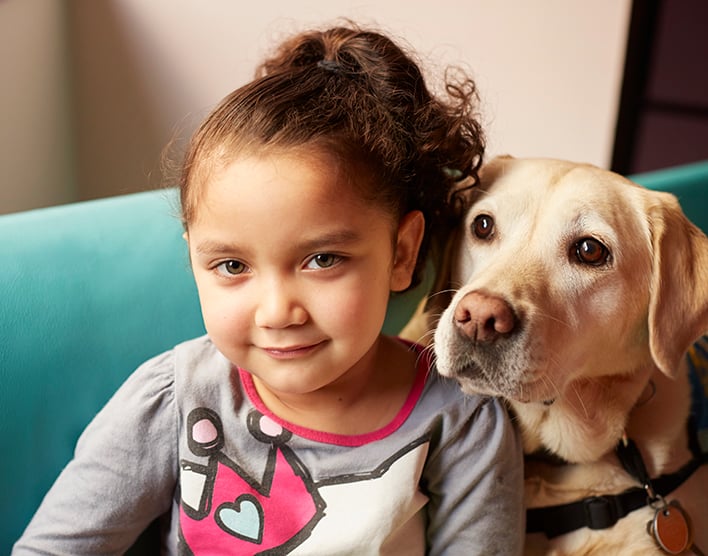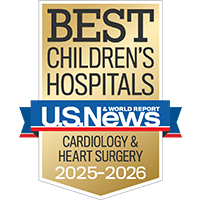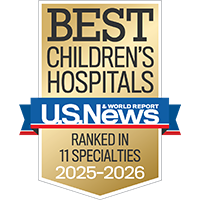Tender wagging care
Our therapy dogs spread joy and smiles at the bedside and throughout the hospital.
Visit Child Life services

Atrial flutter occurs when rapidly fired signals cause the muscles in the atria, the upper chambers of the heart, to contract quickly. This causes a very fast, steady heartbeat.
The "normal" number of heartbeats per minute, called pulse rate, varies with age. The heart beats about 140 times a minute in a newborn, compared to 70 times a minute in an older child at rest. Heart rate is not constant, changing in response to many factors, such as activity, fever and fear. In atrial flutter — when the heart beats too quickly — the heart cannot fill completely with blood, preventing the body from receiving the blood volume it needs to function properly.
Atrial flutter may cause the following symptoms:
It is important to note that some children may not know how to describe what they are feeling during a period of atrial flutter. They may have trouble keeping up with other children or realize they are having "spells" and want to sit down and rest. Sometimes, a child does not experience any symptoms at all.
Atrial flutter may occur spontaneously with unpredictable timing. Therefore, in many cases, the condition requires specialized tests to acquire an accurate diagnosis. If your doctor suspects that your child has an arrhythmia, such as atrial flutter, he or she will order one or more of the following diagnostic tests to determine the source of your child's symptoms.
The treatment for your child's atrial flutter will depend on the type and severity of the condition and the results of various diagnostic tests, such as the electrophysiology (EP) study. You and your doctor will decide which treatment is right for your child.
The following treatments may be considered:
Certain anti-arrhythmic drugs change the electrical signals in the heart and help prevent irregular or rapid heart rhythms from occurring. Medication may be used to convert atrial flutter to a normal rhythm, slow down the heart rate or prevent recurrences. If medication is ineffective, the doctor may try to stop the atrial flutter with pacing or with an electrical cardioversion.
This is the delivery of an electrical shock to the heart using a medical device called a defibrillator. The shock is delivered through pads or paddles placed on the chest. On occasion, cardioversion is performed as an emergency procedure when the heart is beating so fast that the patient cannot maintain a stable blood pressure. The electrical shock will cause the fast rhythm to stop and the heart to restart in a regular rhythm.
If the patient is stable and can tolerate the rhythm, the cardioversion is scheduled ahead of time. Prior to the scheduled cardioversion, it is often necessary to run tests to make sure that there are no blood clots in the heart. Some people need medication to "thin" their blood before having the cardioversion.
For a scheduled cardioversion, the patient is sedated beforehand and his or her breathing is assisted. The electrical shock usually makes the patient's heart convert back to a normal rhythm. Afterwards, to decrease the likelihood of the arrhythmia returning — or to prevent blood clots from entering the general circulation — your doctor may recommend a medication regimen.
To make sure that your child's medication is working properly after two or more days in the hospital, your child may be brought back to the Electrophysiology Laboratory for a follow-up electrophysiology (EP) study. Our goal is to find the medication that works best for your child. On occasion, we admit children to the hospital and monitor their heart rhythm while we start the medication.
Radiofrequency catheter ablation (RFA) is a technique to treat arrhythmia that was pioneered at UCSF Medical Center. It disrupts part of the electrical pathway causing irregular heart rhythms, providing relief for patients who may not respond well to medications, who prefer not to take medications or who can't take medications.
The procedure involves threading a tiny metal-tipped catheter through a vein or artery in the leg and into the heart. Using fluoroscopy or X-ray, doctors guide the catheter through a blood vessel to the heart. Additional catheters, inserted through the vein in the leg and the neck, contain electrical sensors to find the area causing the arrhythmia. This is called mapping.
The metal-tipped catheter is maneuvered to each site in the heart that causes the irregular heartbeat. Radiofrequency waves or current is sent through the tip of the catheter, cauterizing or burning cells to destroy the extra electrical pathways that cause abnormal heart rhythms. In most cases, patients leave the hospital within 24 hours or the same day.
RFA has been proven very effective in treating children with arrhythmias. Your doctor will discuss this treatment and others with you to decide the best option for you or your child.
Cryoablation, sometimes referred to as cryo, is similar to radiofrequency catheter ablation (RFA) in that it is a procedure that disrupts the abnormal electrical pathway in the heart. Instead of burning cells, however, cryoablation destroys cells by freezing them. This newer technology has been used in the Electrophysiology Laboratory at UCSF Benioff Children's Hospital since March 2004.
Cryoablation has been very effective in treating children with arrhythmias. Your doctor will discuss this treatment and others with you to decide which method is the best option.
Like RFA, cryoablation involves threading a tiny metal-tipped catheter through a vein or artery in the leg and into the heart. Doctors guide the catheter through the blood vessel to the heart by using fluoroscopy or X-ray.
UCSF Benioff Children's Hospitals medical specialists have reviewed this information. It is for educational purposes only and is not intended to replace the advice of your child's doctor or other health care provider. We encourage you to discuss any questions or concerns you may have with your child's provider.

Best in Northern California for cardiology & heart surgery

Ranked among the nation's best in 11 specialties
Tender wagging care
